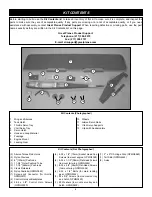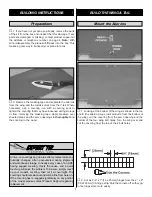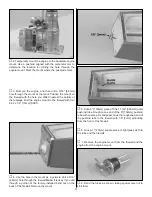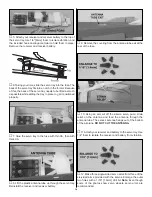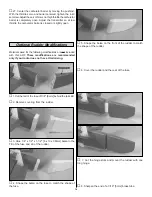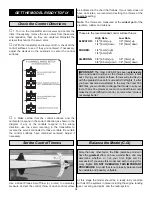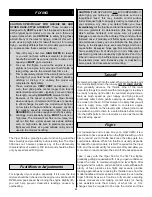
❏
9. Use the brass tube to drill a hole through the fuse in
the approximate location and angles shown in the photo.
❏
10. Slide a 3/16" [5mm] plastic pushrod outer tube (not
included) into the fuse from the rear, going through the large
opening in the former and aligning the front of it with the rear
of the servo mounts. Note: The servo tray is removed for clarity.
❏
11. Mark the pushrod tube where is exits the fuse. Use
course sandpaper to roughen the pushrod tube from the
mark to 1-1/2" [38mm] forward of the mark.
❏
12. Glue the tube to the fuse with thin CA. Allow the CA
to cure and then cut off the excess tube.
❏
13. Attach a small control horn (not included) to the rudder
the same as was done with the ruddervators. Align the holes
in the horn with the hinge line.
❏
14. Attach the pushrods to the ruddervators. Bend the
right ruddervator pushrod as shown. Connect the two
ruddervator pushrods together with two 5/32" [4mm] wheel
collars.
❏
15. Attach the rudder pushrod to the right hand servo
with the Faslink as done with the other servo.
1. Use scissors or a sharp hobby knife to cut the decals from
the sheet.
2. Be certain the model is clean and free from oily
fingerprints and dust. Prepare a dishpan or small bucket
with a mixture of liquid dish soap and warm water–about
one teaspoon of soap per gallon of water. Submerse the
decal in the soap and water and peel off the paper backing.
Note: Even though the decals have a “sticky-back” and are
not the water transfer type, submersing them in soap &
water allows accurate positioning and reduces air bubbles
underneath.
3. Position the decal on the model where desired. Holding
the decal down, use a paper towel to wipe most of the
water away.
4. Use a piece of soft balsa or something similar to
squeegee remaining water from under the decal. Apply the
rest of the decals the same way.
Apply the Decals
17




